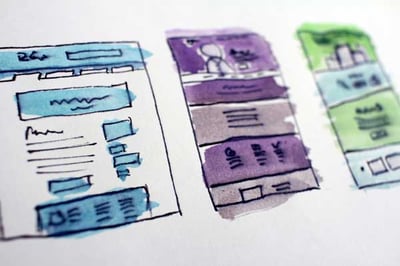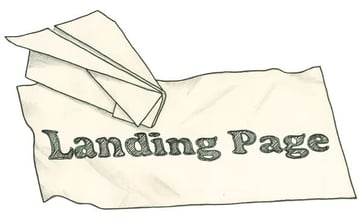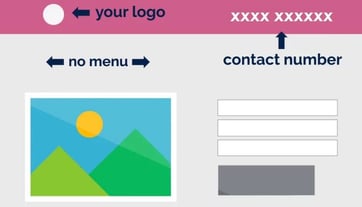Overview:
This blog provides an overview of A/B testing, emphasizing its importance for optimizing landing pages and PPC campaigns. It defines A/B testing as a scientific method to compare two versions of a marketing asset with one varying element to determine which performs better for a conversion goal. The document outlines a five-step process for conducting A/B tests: identifying a problem, analyzing variables, narrowing down elements to test, running the A/B test, and analyzing data to select a winner. It also details key metrics to measure, such as conversion rate, click-through rate, and bounce rate, and provides best practices for successful A/B testing, including testing one variable at a time, having a clear hypothesis, and ensuring statistical significance. The document differentiates A/B testing from multivariate testing and highlights common mistakes to avoid.
As a digital marketer, it’s often tempting to base your marketing decisions off of your initial “gut feeling.” With pay-per-click advertising, and landing pages in particular, that usually results in low conversion. More often than not, those who solely rely on their intuition to predict what will make people click and convert will fall short. In return, this may lead to detrimental results for your digital marketing campaigns.
Rather than trying to guess what will lead to the best results for your next PPC campaign, it’s time to run an A/B test (if you’re not running them already). A/B testing for landing pages can take your marketing efforts to the next level and help customers move more effectively through the sales and marketing funnel. In a nutshell, the results of an A/B test can effectively determine which tactics work and which don’t work.
What is A/B Testing and Why is it Important for Successful Landing Page Optimization?
A/B testing is scientifically known as “two-sample hypothesis testing.” In the digital world, it is also commonly referred to as “split testing” or “bucket testing.” According to Optimizely, A/B testing is “an experiment where two or more variants are shown to users at random.” From there, based on statistical analysis, running an A/B test helps determine which of the variations performs better for a given conversion goal.

Within the digital marketing world, A/B testing is the process of comparing two versions of a marketing asset with just one varying element. Marketers most commonly run these tests on landing pages, display ads, and emails. The main purpoto se of running these tests for digital marketing campaigns is to see which variation performs best.
In its simplest form, running A/B tests can help you gain a better understanding on whether users like version A or version B of your campaign.
How Does A/B Testing Work?
A/B testing works by comparing two versions of something, like a landing page, ad copy, or call-to-action, to see which one performs better based on real user data. Instead of guessing what might resonate with your audience, A/B testing lets you prove it with actual results.
Here’s how it works step-by-step:

- Choose one variable to test.
This could be a headline, image, button color, or even the layout of a page. The key is to test one change at a time so you can isolate its impact. - Create two versions (A and B).
Version A is your original (the control), and version B includes the new change (the variation). Everything else should stay the same. - Split your traffic.
Your audience is randomly divided so that half sees version A and the other half sees version B. This ensures an even, unbiased comparison. - Measure the results.
Decide which metric matters most: click-through rate, form submissions, purchases, etc. That’s your conversion goal. - Pick the winner.
The version that delivers better results becomes your new go-to. Simple, data-backed, and effective.
The Importance of A/B Testing for Your Landing Pages
Landing pages are vitally important to lead conversion and it’s crucial to understand the importance of landing pages. Landing pages are standalone pages that serve a single and focused purpose. They play a vital role within the buyer’s journey, with a strong focus surrounding lead generation and lead conversion.
So, where does A/B testing come into play? In order to create an effective landing page that converts, you will need to conduct tests on a number of variables and measure what works best. A/B testing is, thus, crucial for successful landing page optimization and for your paid Google advertising efforts as a whole.
A/B Testing vs Multivariate Testing
A/B testing involves comparing two versions of a page by changing a single variable—like a headline, call-to-action (CTA) button, or image—to determine which version performs better. It’s best used when you have a clear, focused hypothesis and want fast, actionable results. Because you’re testing one change at a time, it’s easier to isolate the impact of that element. A/B testing is ideal for marketers working with lower website traffic or when testing foundational elements. It's simple to set up, quick to analyze, and great for learning what resonates with your audience—one decision at a time.

Multivariate testing, on the other hand, is more complex. Instead of testing one variable, you test multiple variables simultaneously to see how they interact with each other. For instance, you might test two different headlines, three hero images, and two CTA button styles—resulting in twelve unique combinations. Multivariate testing helps you understand which combination of changes delivers the best performance, rather than evaluating elements in isolation. However, because you're testing several variables at once, you’ll need significantly more traffic to reach statistically valid conclusions. It’s powerful, but not practical for every website or situation.

Why Do We Do A/B Landing Page Testing?
When it comes to digital marketing, even small changes can have a big impact on performance. A/B testing helps you figure out what actually works by letting your audience “vote with their clicks” in real time. Instead of relying on assumptions or gut instinct, you’re making informed decisions based on real user behavior.
Here’s why A/B testing matters:
- It reduces risk—before rolling out a big change across your entire website or ad campaign, you can test it with a small audience. If it flops, you’ve saved time, money, and credibility.
- It improves ROI—whether it's an ad headline or button color, A/B testing helps you identify the highest-converting version, so you're getting more results from the same spend.
- It supports continuous improvement—A/B testing is an easy way to keep optimizing. You’re always learning, adjusting, and getting better results over time.
- It puts the user first—at the end of the day, your audience tells you what works. A/B testing keeps your marketing aligned with their preferences, not your assumptions.
How to Decide What to Test
Knowing that you should run A/B tests is one thing; knowing what to test is where the strategy comes in. You don’t want to guess. You want to prioritize tests that give you insight and move the needle.
Here’s how to decide where to start:
1. Look at the Data First
Before making any changes, dig into your analytics. Where are users dropping off? Is your bounce rate high? Are people visiting but not converting? Use data from Google Analytics, heatmaps, or session recordings to pinpoint friction points.
2. Start with High-Impact Elements
Focus on the parts of your landing page that directly influence user decisions:
Headlines—Is it clear and compelling?
Call-to-Action (CTA) – Is the copy persuasive? Is the placement right?
Forms—Too long? Too intimidating?
Visuals—Do they support the message or distract?
These are the areas where small tweaks often lead to big changes in performance.
3. Prioritize Based on Volume and Value
If you have multiple landing pages, start testing on the ones that:
Get the most traffic
Drive the most leads or revenue
Support high-value campaigns (like paid ads)
This ensures your tests have enough data to deliver reliable insights and that any improvement makes a real difference to your bottom line.
4. Use User Feedback to Identify Pain Points
Comments from users, via surveys, live chat, or even social media, can highlight what's unclear, frustrating, or missing. If people keep asking the same question, test a change that addresses it directly.
5. Build a Hypothesis
Rather than testing at random, frame each idea as a hypothesis:
“If we shorten the form, more people will complete it because it feels less intimidating.”
This keeps your tests grounded in logic, not guesswork, and helps you learn something valuable regardless of the outcome.
6. Consider Mobile vs. Desktop Experience
User behavior can vary widely across devices. What works well on a desktop might flop on a phone. Make sure you test with responsiveness in mind, or better yet, run device-specific variants.
What to A/B Test
Landing page A/B testing isn’t about changing things at random; it’s about understanding how small details impact user decisions. While it might be tempting to start tweaking colors or button shapes, the most effective tests begin with strategic thinking and audience behavior in mind.
Let’s break down the elements worth testing and why they matter more than you might think:
Headlines
Your headline sets the tone for everything that follows. Even subtle changes in phrasing can shift how visitors perceive your offer. Surprisingly, clarity often outperforms cleverness. Testing different tones, urgent vs. reassuring and specific vs. broad, can reveal which message better resonates with your audience’s mindset.
Call-to-Action (CTA)
The CTA isn’t just a button; it’s the tipping point between interest and action. What many marketers miss is that the surrounding context of a CTA (placement, proximity to value messaging, or even whitespace) can impact performance just as much as the wording itself. It’s not always about making the button louder; sometimes, it’s about making the ask more logical and timely.
.jpg?width=335&height=474&name=unnamed%20(17).jpg)
Form Fields
There’s a natural tension between collecting the data you want and minimizing friction for the user. But it’s not always about fewer fields; some audiences actually expect a more thorough form if the perceived value is high. A/B testing helps you discover what level of effort your audience is comfortable with before dropping off.

Visual Hierarchy
Most users scan before they read. Visual hierarchy, how elements are ordered, sized, and spaced, guides their attention. Testing layout adjustments can reveal whether people are getting to the most important information quickly enough. If users are missing key content, a subtle reordering of elements may outperform a full redesign.
.jpg?width=377&height=533&name=unnamed%20(18).jpg)
Trust Signals
Social proof is more than adding a logo strip at the bottom of the page. The type, format, and placement of trust signals all affect credibility. For instance, peer reviews often outperform corporate endorsements. A/B testing can show whether your audience values recognizable brand logos, detailed testimonials, or star ratings more.
Content Density
There’s a fine line between being concise and being vague. Reducing content can increase focus, but also risk leaving questions unanswered. The sweet spot varies by industry, product complexity, and stage of the buyer journey. A/B testing can help determine if visitors want a quick takeaway or a deeper explanation.
.jpg?width=312&height=441&name=unnamed%20(19).jpg)
Load Time Impact
Sometimes, the test worth running isn’t visual at all. Minor changes in load time (especially on mobile) can quietly affect bounce and conversion rates, especially if your test variant adds rich media or scripts. Consider load speed as a variable worth isolating during testing cycles.
Page Flow
It’s easy to assume your page is being read top-to-bottom, but heatmaps and scroll data often reveal otherwise. Visitors might abandon the page halfway through or jump back and forth between sections. A/B testing different flow structures can surface better engagement paths, helping you guide users more intentionally toward action.
Metrics to Measure While Landing Page A/B Testing
Running an A/B test is just the beginning. To understand which version actually performs better, you need to focus on the right data points. Below are key metrics that help determine whether your changes are making a measurable impact:
Conversion Rate
This is your most important metric. It tells you the percentage of visitors who completed your desired action, whether that’s filling out a form, downloading a guide, or booking a call. The version with a consistently higher conversion rate (with statistical confidence) usually wins.
Click-Through Rate (CTR)
If your page includes multiple steps (like a button that leads to a form), CTR helps you gauge how well your CTA or page design is prompting action. A low CTR can indicate weak messaging or a CTA that’s not clear enough.
Bounce Rate
Bounce rate shows the percentage of visitors who land on your page and leave without doing anything else. A high bounce rate might signal that your messaging, design, or offer isn’t resonating, or that the page is taking too long to load.
Time on Page
Are users engaging with your content or leaving quickly? If one variation holds attention longer, it could suggest better structure or relevance, especially for educational or content-heavy landing pages.
Scroll Depth
This tells you how far down the page people are scrolling. If very few make it past the halfway mark, your content may be too long or not compelling enough to keep their interest.
Form Abandonment Rate
For landing pages with forms, it’s useful to know how many people start filling out the form but don’t complete it. This can help you identify friction points, like too many required fields or unclear instructions.
Return Visitor Behavior
Sometimes, the winning version isn’t just about the first visit. Look at how often users come back and whether their actions change over time. A version that brings visitors back may be more valuable long-term.
Lead Quality (if applicable)
More conversions aren’t always better if they’re low quality. Tracking downstream metrics, like lead qualification or sales outcomes, can give a fuller picture of whether your landing page is attracting the right audience.
A/B Testing Process
Step 1: Identify the problem
First and foremost, you’ll need to figure out why your landing page isn’t converting. Start by pinpointing a specific problem. For example, you own an e-commerce store and notice that very few sales are coming from the landing page linked to your email campaigns. You notice that your emails have a high open and click-through rate, yet very few are actually converting.
Step 2: Analyze the variables
Once you’ve identified the problem, it’s time to analyze the user data. Specifically for landing pages, there are so many elements you can analyze, and it can become extremely time-consuming. Instead, start by figuring out and prioritizing which elements you want to focus on and target first. According to MailChimp, you can choose to conduct A/B tests on a number of variables. Variables and elements of your landing page that you can choose to test include (but are not limited to):
-
Colour scheme
-
Number of types of images
-
Call-to-action button design and placement
-
Headings and subheadings
-
Special product/service offers and pricing
For example, you’re analyzing your landing page and notice that your call-to-action button is not very visible to users. Maybe it’s the placement of the button, or maybe it’s the size that’s affecting the conversion rate. At this stage, you start brainstorming where you can move the button or how you can resize it to help generate a higher conversion rate.
Step 3: Narrow down the elements
Now that you have analyzed the data, pick one element you want to test and figure out how you want to test it. Let’s say you choose to test the placement of your call-to-action button. Let’s also say that the original placement of your button was hidden all the way at the bottom of your landing page. You are now able to develop a hypothesis stating that users might be more inclined to click through to your website if the call-to-action button were placed closer to the top of the page.
Step 4: Run the A/B test
Congratulations, it’s time to conduct the A/B test! You’ve identified the problem, analyzed the data, and developed a hypothesis. At this stage, create a separate version of your landing page, implementing your new idea for the placement of your call-to-action button. Run an A/B test between the original version and the current version for the next 24 to 48 hours.
Keep in mind that if you are testing the placement of your button, the only thing you should change is the location of the button. Keep the design of your landing page the same so that you can easily pinpoint which version’s positioning performed better.
Step 5: Analyze the data
Once the A/B test is complete, it’s time to analyze the data and crown the winner. Take a look at the results and see whether or not the newer version of your landing page was able to drive noticeable changes. If it did, hooray! If not, you can try testing a different element of your page.
Once you have conducted the first round of your A/B test, you can repeat the process again to find a new “challenger” for your “champion."
Best Practices for Landing Page A/B Testing
Running A/B tests on landing pages isn’t just about switching colors or headlines; it’s about collecting real, actionable data to inform smarter marketing decisions. That said, not all A/B tests are created equal. Here’s how to make sure yours are structured for meaningful results:
Test One Variable at a Time
Changing multiple elements at once might feel efficient, but it makes it impossible to know which change drove the result. Whether it’s your headline, button text, or hero image, stick to one variable per test to keep your insights clean and reliable.
Start with a Clear Hypothesis
Effective testing starts with a purpose. Don’t run tests just to see “what happens.” Instead, define a clear hypothesis, e.g., “Reducing the form fields from 5 to 3 will increase submissions by reducing friction.” That makes your outcomes easier to interpret and act on.
Segment Your Audience Carefully
Not all visitors behave the same way. If possible, segment by traffic source (e.g., paid vs. organic), device (mobile vs. desktop), or behavior. This way, you avoid applying broad conclusions to specific subgroups and uncover insights you might’ve missed otherwise.
Give Your Test Enough Time and Traffic
Ending a test too early can lead to misleading results. Let it run until you have statistically significant data. How long that takes depends on your traffic volume and the size of the performance gap between versions, but patience pays off.
Use Reliable Tracking Tools
Make sure you're capturing the right metrics: form completions, click-throughs, bounce rates, and heatmaps. Tools like Google Optimize, Hotjar, or HubSpot’s A/B testing features help ensure you're not just testing; you’re tracking what matters.
Avoid Mid-Test Changes
Once your test goes live, resist the urge to tweak it midway through. Even small changes can corrupt your results. Let the test run its course uninterrupted, then analyze and iterate afterward.
Don’t Just Focus on Winners, Learn from Losers
Not every test will deliver a big win. That’s okay. Even if one variant underperforms, the insight you gain about your audience’s behavior is still valuable and helps refine your next test with more clarity.
Optimize for Mobile First
Most traffic comes from mobile devices. If you're only testing on desktop layouts, you’re missing the bigger picture. Make sure your A/B tests are responsive, and check performance across screen sizes and load speeds.
Track More Than Just Conversions
It’s easy to focus on form submissions or purchases, but also look at micro-interactions: scroll depth, time on page, or interaction with trust elements. These signals can reveal friction points you might not notice from top-line metrics alone.
Common Mistakes to Avoid While A/B Testing Landing Pages
A/B testing is one of the most reliable ways to improve landing page performance, but only if it’s done correctly. Without a thoughtful approach, it’s easy to misread the results or make decisions that lead you further away from your goals. Here are common pitfalls to watch for:
1. Testing Too Many Changes at Once
If you change the headline, CTA, image, and form all at once, how do you know which change made the difference? Isolate one element at a time to keep your data clean and conclusions clear.
2. Ending the Test Too Early
Patience matters. Running a test for just a day or two might not give you reliable results. Let your test reach statistical significance, usually a few hundred conversions or at least a couple of weeks, depending on traffic.
3. Ignoring Statistical Significance
Just because one version has a higher conversion rate doesn’t mean it’s better, yet. Make sure the difference in results is statistically significant before declaring a winner. Many A/B testing tools include this calculation automatically.
4. Testing Without a Clear Hypothesis
Always start with a reason. Are you testing a shorter form because you think fewer fields will reduce friction? Great, write that down. A clear hypothesis keeps your testing focused and purposeful.
5. Not Segmenting Your Results
Different audiences behave differently. A variant might perform well for mobile users but not for desktop visitors. Break down your results by device type, traffic source, or location when possible.
6. Overlooking External Factors
If you're testing during a holiday, ad campaign, or unexpected site issue, your results may be skewed. Always account for outside influences that could impact behavior.
7. Failing to Implement the Winner
It sounds obvious, but it happens: teams run tests, see clear winners, and then forget to roll them out. Once you've found a winning version, make it the default and continue building from there.
8. Testing Without Enough Traffic
AB testing needs a decent sample size. If your landing page only gets a handful of visits per week, consider using qualitative feedback or heatmaps instead until traffic grows.
What is Statistical Significance in Landing Page A/B Testing?
Statistical significance is what tells you whether the difference in performance between two landing page variations is real or just the result of chance.
When you run an A/B test, you're essentially asking, "Is Version B truly better than Version A, or did we just get lucky?" Statistical significance gives you the confidence to answer that question with data.

Why It Matters
Without statistical significance, you could end up making decisions based on false positives. For example, if you launch a new headline and conversions spike after just a few hours, that might seem like a win—but if only 20 people visited the page, it’s not enough to trust the result. You’re acting on noise, not insight.
How It Works
Statistical significance is measured by a p-value, which tells you how likely it is that your results happened by random chance. In most marketing tests, a p-value of 0.05 or lower (aka 95% confidence) is considered statistically significant. That means there’s only a 5% chance the outcome was random—and a 95% chance it’s reliable.
What Affects Statistical Significance
- Sample Size: The more visitors your test receives, the easier it is to detect meaningful differences.
- Conversion Rate Difference: The bigger the gap between Variant A and B, the faster you'll reach significance.
- Consistency Over Time: Sudden spikes or dips can throw off results. It's best to test over several days or weeks to account for daily patterns and traffic fluctuations.
Tools That Help
You don’t need to calculate it manually. Most A/B testing platforms, like
- Google Optimize
- Optimizely
- VWO
- HubSpot A/B tools
…will automatically tell you when your results are statistically significant.
Test Your Landing Pages Today!
In the long haul, A/B testing can help ignite your digital marketing campaigns. It is a fantastic method for figuring out your promotional or marketing strategies. It also helps marketers make more informed decisions on their PPC campaigns. It’s time to say goodbye to the good old guesswork and time to start digging deeper and analyzing the variables. Ultimately, A/B testing for landing pages can help improve the ROI for your next campaign, and you definitely won’t regret it.
Do you need help A/B testing and optimizing your landing pages? We can help. Speak to an expertfor a consultation.






